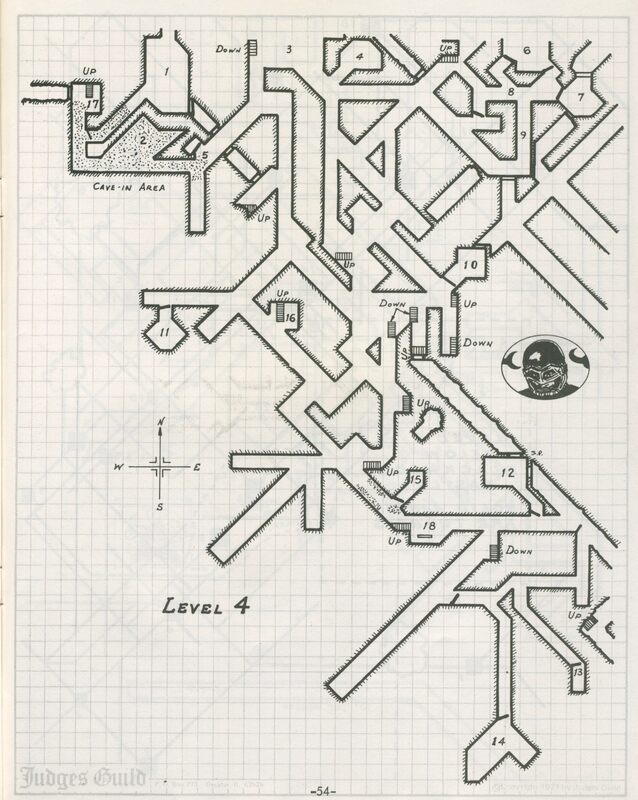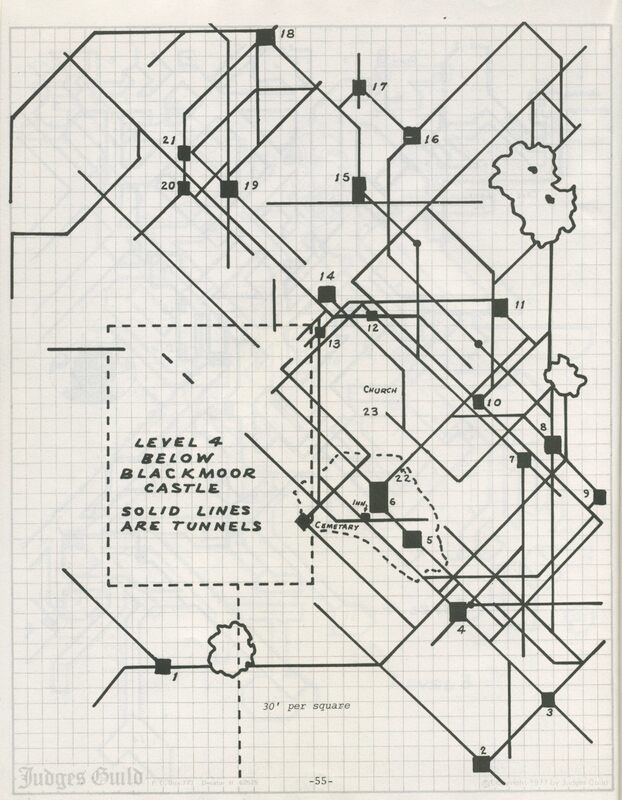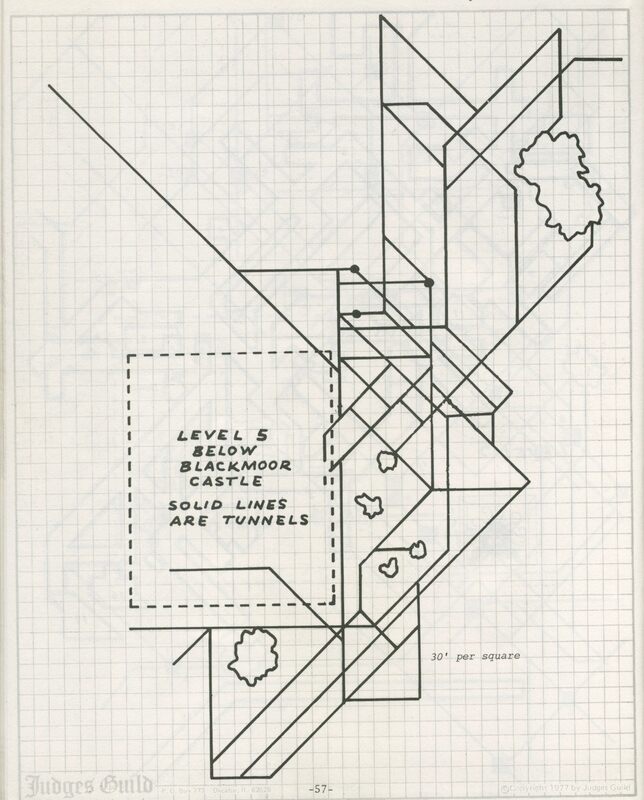QUICK AND DIRTY DISPOSABLE DUNGEONS - PART 8: Mapping your Dungeons, adding mood and scale6/17/2020 Continued from this post: https://www.secretsofblackmoor.com/blog/quick-and-dirty-disposable-dungeons-part-7-the-side-quest-to-retro-rpg-terror As I continue the design of my caves, I think it's time to talk about mapping a bit. If you are an older gamer, much of what I write is useless to you. You likely already know all of this info via your own gaming experience. As a side note. I grew up partly in Italy during the 1960's. I've been in a lot of castles, thus my mental image of our dungeons is a bit different. My father's research program was located in a napoleonic fortress. Strangely, my parents would let me wander the place alone. It was very unsafe. The central stairwell, a big round shaft, had no railings and I recall the steps being at about a 45 degree angle. One day I decided to explore the third story of the place. Going up was easy. Coming down was frightening. I think the drop to the floor below was about 60-80 feet. I was probably 4-5 years old and my little knees were shaking. Did I mention scorpions? The place was crawling with scorpions. My sister and I would catch them. Visualizing your Dungeon Make no mistake, Dave Arneson invented dungeon adventures. Although his dungeon was only 6 levels deep when he first created it, it would later expand much deeper and become a 10 level mega dungeon. We actually made a 3d model for the film to show just how big Blackmoor Dungeon is: https://www.youtube.com/watch?v=_y7fYY1JUPI Not only did Arneson expand his dungeon vertically, he expanded it sideways. His understanding of an underground place was very imaginative. Thus while his maps may not seem too exciting I am convinced his descriptions as he ran these maps in a game must have been amazing. Many people have examined his maps and wondered why the stair wells do not match up. You can lay the maps one on top of the other and no two stair wells will align properly. This is because his stairs are not like stairs in an apartment building. We aren't looking at modern architecture in his dungeon. This is tunnel work down into the ground. Once you step on a stairwell you could be traveling 50' down before you end up on the next level. Arneson's maps reveal that these stairs are often curved, winding, and narrow. They corkscrew through the stone and can be disorienting. Stairwells are often overlooked by Referees. You can put things in stairwells, or have encounters there. The stair treads in the Orcian way would suddenly flip down and become a slide and you would be delivered to the deep levels of the dungeon where the orcs waited for victims. This brings me to another important aspect of RPG play, the descriptive role playing done by the Referee. Immersion is the Name of the Game Our underworlds are dark and terrifying places. Yet I often see players and referees turn their games into a simple: 10' 20' 30' a door at the end of the passage. I also see many gamers assume that talking to each other and the people played by the Referee, the NPCs, is role playing - NO NO NO! Everything you do in the game is Role Playing. The most important aspect is when your referee describes a location. Nothing in reality is empty and devoid of information. Look around you right now and examine everything as if you'd never seen it before? Now imagine you are exploring deep underground in a place that is completely alien to you. As a referee one wants to fill every place in the dungeon with mood setting detail. This means Role Playing these things as your players encounter them. Ask yourself what is unique about this location? As you enter the room you notice that this place is very dry. Rock dust has accumulated on the floor and you can see chaotic imprints from the passage of many feet. The impressions range from single bare footprints to long dragging snaking patterns. Although these walls are made of mortared stone blocks, someone has taken the time to draw eyes on every inch of the walls and ceiling in chalk. In the middle of the floor you see a single candle burning. As you draw close to examine it you realize the candle is actually a severed human finger that has been left upright in the middle of the floor. The flame of the finger-candle is actually a tiny magical fire. Ok, in my book eyeballs and severed fingers will elicit feelings. These aren't good feelings either. This place is getting creepy. My example is a bit special. Yet, you should be making everything a little creepy. Cobwebs, streaks of dried blood, water dripping, creaking sounds, the air feels heavy, a profound tomb like silence. These may seem cliche but they work! Referees don't just adjudicate games, it's their job to create cinematic ambience and hopefully a feeling of dread. All of this leads to player immersion. Not every description needs to be extensive, you can mix it up with shorter ones. Yet it is these details that draw players into the game reality. Consider that what the referee is doing, is a kind of hypnosis. When it works, your players will become terrified of your underworld. Of course you can't make notes for all these details and many of them are superfluous. You are going to have to make it all up as you go, right in the moment. A while back I wrote about dungeons actually being a gothic horror setting transposed into a fantasy setting. I may not have emphasized how important feeling is. Horror settings are all about feeling. It's your job to make a dungeon creepy. You can over-ride a player's tendency to play the game as a game if you succeed in triggering an emotional response by manipulating their sense of what is normal. I'm sorry to tell you this, there is no safe gaming in my dungeon, because dungeons aren't safe. The entire point of running a dungeon is to trigger uncomfortable feelings for your players during the course of a game. You can read more about gothic horror in dungeons here: https://www.secretsofblackmoor.com/blog/what-if-you-arent-playing-the-game-right-or-on-the-origin-of-the-dungeon-adventure-game-as-the-first-gothic-horror-rpg Ok, so what I am saying is that the DM role plays reality. Pretty simple really. Lets get back to talking about maps. Ok, we've come to a better understanding of how dungeon maps should be interpreted. There's a lot of stuff that never gets written down, it's made up during a game. And each level should be separated vertically by some distance.
Scaling the Map Arneson's Blackmoor was drawn in several scales. The upper levels were drawn on a 1 square is equal to 10' grid. The 4th level and the 5th level were much more expansive. Those two levels come with a standard map and a larger map drawn to a 30' per square scale. The reason for this is that those levels run right under the town of Blackmoor. You can start up in the castle and work your way down and pop up anywhere in town. The deepest level is drawn on a 20' per square scale. This is where the big critters live, so you are going to need wider tunnels for them to get through. On the larger scale maps that show sections below the town, tunnels are drawn as lines. The caves down here can now be really large. Scaling the Riverine Cavern Complex I wanted this tunnel complex to be very large. Big tunnels that go for hundreds of feet. It should be a mix between a dungeon and a wilderness. I've decided not to scale my map at all. I will just put breaks between points of interest and note the distances. The players will begin at the top of a tall mountain and then come out at the bottom thousands of feet below. I will describe each location, yet I am not going to bother with a detailed map until the players are exploring the location. The Ice slide The entire cave complex is cold. Hopefully everyone has brought a cloak. One side passage is so damp that ice has formed on everything. Before long the front rank of players will find themselves on a steeper incline as the passage winds downward. They will have to keep from slipping and sliding further down. Iron spikes and rope would come in handy here. Anyone one who loses their footing will slide 100 feet to the next location. The Wraiths At the bottom of the ice slide is the chosen haunt of some wraiths. These ladies are very affectionate and willing to give a PC that special experience level draining touch. If you play OD&D, or AD&D, consider having 2 of these creatures vs. a party of 1st level characters. Keep the encounter level inappropriate, IMHO. This is a really high risk encounter. i.e the best option is to run away. One should expect to lose a couple PC's here if they aren't careful. If the players do manage to kill these undead, they should find a lot of treasure here. High risk means great reward. Everything from coins to a variety of magic items will help boost up who ever lives through fighting these wraiths. That takes care of today's venture into the caves. If you haven't already, you can check out some of our free videos on You Tube. This one is a favorite of mine: https://www.youtube.com/watch?v=gM8GHeFVHyA&t=131s
1 Comment
Leave a Reply. |
DVD'S, Books, T-shirts, games and more available on our store.
AuthorSecrets of Blackmoor is a Feature-length documentary about the birth of the “Mother of all Games;” Dungeons & Dragons. Archives
January 2024
Categories |
Privacy Policy
All Contents Copyright © 2023 The Fellowship of the Thing, Ltd. - All Rights Reserved
All Contents Copyright © 2023 The Fellowship of the Thing, Ltd. - All Rights Reserved




 RSS Feed
RSS Feed